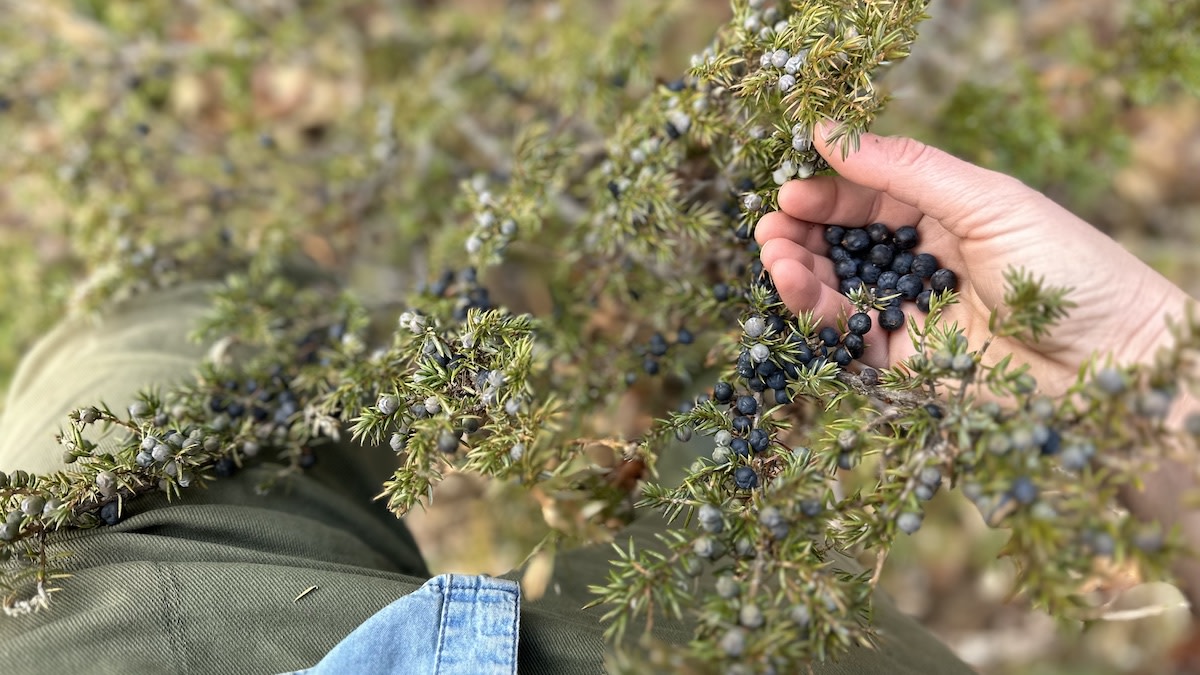
Juniper is known in most circles (American, at least) for being the star flavor in your gin and tonic, a drink I associate, lovingly, with summertime (unless in the exempt arena of an airport or a casino where I enjoy them year-round). But beyond gin and beyond summer, juniper is the staple spice of winter foods in much of the world. From kraut, to game pies to sauerbraten—every place that juniper grows has humans there that cherish it for both flavor and medicine, and it packs a punch in both departments.
If you don’t care for the pungency of gin, don’t write juniper off just yet. Its sharpness becomes soft with cooking, and it lends a sultry depth to dishes that you’d never guess was akin to a martini, trust me. It’s native to most states in North America, and being an evergreen, you can forage for it year-round. If you thought berry-picking ended in September, let me tell you about picking juniper in the snow so you can experience what your winter tastes like.
How to Forage For Juniper
Common Juniper (Juniperus communis), is the most widespread of the junipers, growing in the harshest nooks and crannies across the whole northern hemisphere. There are other edible species of Juniper, too, (though not all are) but this is the most abundant and most commonly used, so it’s the one we’ll talk about. While many junipers grow into upright tree forms, sometimes referred to as cedar trees, common juniper is a low-growing, prostrate, shrub. While most other juniper needles mature from prickly to eventually scaly and smooth, common juniper needles keep their sharp points. Because of this, I suggest wearing long pants, toed shoes, and gloves when you step into the juniper hedge, or you will be needled.
I find it most often laying low and sunbathing in places like the edges of farm fields and livestock pastures, along exposed rock walls, power lines, sunny logging cuts, on the sandy edges of ATV trails and dirt roads, rocky outcroppings, and stony ledges. I’ll occasionally see a small specimen inside canopied woods, but it’s likely a relic from when those woods used to be pasture, and I’ve never seen berries on a shrub that wasn’t in absolute full sun. Juniper can root in seemingly no soil at all, making it a common character of disturbed places and areas prone to erosion. You can often spot it easily from the road, where they plant it along embankments to hold the soil. I don’t recommend picking from roadsides, but it’s a good place to access plants for identification and familiarity’s sake.
Common Juniper will be low, spreading from woody branches with rough, peeling, brown bark. The evergreen leaves are flat, sharply pointed needles with a pale stripe on the upper surface, arranged in whorls of three around the branch, but not overlapping to cover the branch (this overlapping to cover the branch would indicate a different species). The berries are actually not berries at all, but cones. However, they are culinarily and medicinally referred to as berries, so that’s what we’ll call them here.
The berries take 18 months to ripen, and you’ll often see both the green, immature berries on the branch at the same time as the deep purple, mature berries. Only the female plants produce berries, so if you find a patch of juniper and you don’t see berries on the first plant, be sure to check them all; the males and females are often intermingled.
The one plant that would be worrisome to confuse common juniper with would be American Yew (Taxus canadensis), which has highly toxic seeds inside the fruit, but there are many notable differences including habitat and that the fruit is bright red, with a short window of ripening, as opposed to juniper berries which ripen slowly from green to dark purple and are present on the (fertile female) plant, in some stage, all year long.
How to Use Juniper Berries
Note: If you are pregnant, nursing, or wish to become pregnant, you should not consume juniper, sorry.
Some people describe the flavor as piney, but the berries have a syrupy, mineral depth of flavor all on their own. Many say the young, green berries taste bitter but I think they bite of gin, pine, citrus, and hops while the ripe, purple berries taste more of red wine, dried fruit, and pepper, which people throughout history have used them in place of.
I love to use the green berries for their brightness alongside, or in place of, citrus in cocktails, mocktails, cured fish, or baked goods, especially citrus desserts. I like to use the mature, purple berries to add depth to things like ferments, pickles, cured meats, jams, and my favorite—pan sauce, preferably with some kind of stone fruit, served over seared venison, wild boar, grouse, or duck.
To get a sense of the flavor, of any aromatic plant, really, start with tea. Crush a handful of berries, toss them in a mug and steep them in hot water for a few minutes to get the true essence of their flavor and aroma. Then try a simple syrup: a handful of crushed berries, simmered in a 1:1 sugar to water solution. Some people call this “gin syrup,” and it’s amazing in cocktails or non-alcoholic drinks. Add a dropperful to things you want to brighten up like glazes for pastry or meat.
I like to make small, seasonal batches of “Maine gin” throughout the year by soaking a handful of crushed juniper berries and a sampling of other local aromatic plants in a quart jar of vodka for a few weeks, tasting every other day as all plants release their flavors at dramatically different rates.
Grind the berries into your spice blends and dry rubs, infuse a vinegar, or use them to lend that special “something” to sausages, sauerkraut, and pickled and preserved things. Add a few berries to anything that needs a lift.




